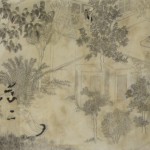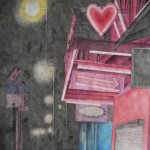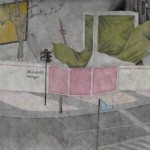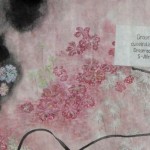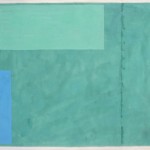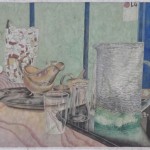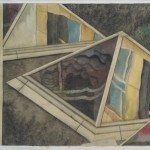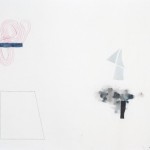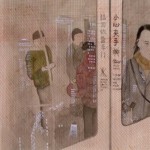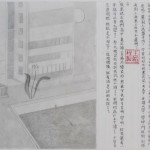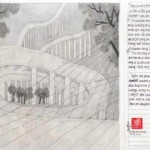Crossing Worlds : Wang Taocheng Works on Paper: Artist Statements
January 11th, 2012 - January 15th, 2012
- Show Info
- Artist Statements
- Wang Taocheng’s narratives explore notions of time, identity the psyche of the artist
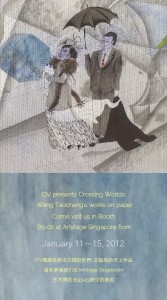
Wang Taocheng: Between Face and Lips, ink, mineral pigment, pencil, acrylic, 400 x 33cm, 2011
This scroll is about Taunusstrasse and Kaisserstrasse in the area around the central railway station in Frankfurt. The city has Germany's second biggest red light district, which is also the site of many drug transactions and a casino. This character is very at odds with the rest of Hamburg, which is rich, elegant and sleepy. One glance reveals the brutality of the gambling and prostitution – and the great wealth which it creates. This takes us right back into the financial district and the handsome young German men who expend their energies nearby, thus completing the cycle.
This is an airport city. Everything is chaos, lies, struggle, vulgarity and fleeting. Walking around the red light district, lonely and aroused, there is an urgent desire to prove our sense of dignity. In this temporary sphere, there is no difference between bankers, policemen and drug dealers.
The composition is divided into five sections; which include scenes from photographs and abstract color fields. The figurative sections feature an element of perspective, while the abstract parts offer no hints at meaning, thus weakening the narrative character of works by failing to provide connections between images.
From the right to the left, the first section is a sign for a Turkish Pizzeria on Taunusstrasse. There is a fiery red heart-shaped lightbox above. This type of lightbox reminds us of the large Euro-shaped light box installation of the European central bank not far away. Beside this scene I’ve written a saying in German by Lu Xun: “something1 rotten may be as magnificent as peaches and plums.”
The second section is the construction site of the DB-Deutsche Bahn building, which is between Taunusstrasse and Kaiserstrasse. Here, piles of high-grade construction materials are covered by plastic sheeting which dances with each gust of wind. DB is the abbreviation of both Deutsche Bahn (the German railroad and logistics company) and the Deutsche Bank (Deutsche Bank).
The advertising slogan on the building reads “DB. Zukunft Bewegen” (German trains move towards the future). I’ve placed it so that it faces the red light district, this juxtaposition creating a subtle joke.
The last section which includes a Japanese decorative pattern of images references the greenhouse flowers from South Africa in Perlman Garden. Visitors have to look at these small flowers through glass – everything needs to be seen through glass. The public seldom gets the chance to enter into the top floors of the bank building or the upper echelons of the brothels. Even they have to have a look at the naked women through glass. At the end of the scroll is Li Bai’s “Pusa Man.”
“The mansion in creeping; dusk is clad,
Someone up there is sad.” 2
1. This is from Lu Xun’s “Collection of Random Thoughts No. 39” 随感录三十九 where he attempts to say how ugly things can be beautiful, for instance a face red and swollen from an injury might create the impression of health conveyed by rosy red cheeks.
2. Li Bai’s Poem “Pusa Man” A flat-top forest stretches far in embroidered mist; A cluster of mountains, cool, is tinged with heartbreak blue. The mansion in creeping dusk is clad, Someone up there is sad. On marble steps I stand forlorn Birds fly hurriedly by back to roost. Where, pray, is the way home? Along a string of wayside pavilions I roam.
Wang Taocheng: Sister,chinese ink, pencil,180 × 33 cm, 2009
This piece reflects the suicide of one of my friends’ younger sisters. She told me this story one day on the bus to Pudong (a suburb of Shanghai). The basic problem was that girl's mother was a dictator, making all the decisions, and she was not able to do any of the things that she wanted to do. Because she was from such a poor family, she felt oppressed and developed a sense of inferiority.
Speaking from the mother’s point of view, no one can say she doesn't love her daughter. She had a terrible education and she was biased and blind to how this treatment affected her daughter. She only knows how to make noodles and bargain at the market; the world that surrounds her is very crude and unsophisticated.
Compared with Western kids, Chinese children are usually less mature and independent – it’s somewhat bizarre. With careful observation, we can see that the childhood of a Western kid corresponds with the idea of an actual childhood. The same can be said for adolescence.
Western kids learn useful knowledge, play fun games, and complete the obligations and responsibilities they ought to undertake. At the same time, each individual has his own personality and identity. However, the growth and development of Chinese kids is as messy as the history of modern China. They face a lot of homework, exams and pressure and they wear awful clothes.
So this is how they grow up, using up their time, continuously working hard. Suddenly they realize that their efforts will not bear fruits but their parents continue force them. This idea of stolen youth is a very typical theme in Chinese culture.
Meanwhile, they don’t get any kind of personal development. Such a tragedy inevitably happens; and this time I’ve conveyed it by trying to imitate Song Dynasty ink paintings.
Wang Taocheng: Untitled (Plank Bar and the Abandoned Garden of Commerzbank), pencil, ink, water color on xuan paper, 390 x 33 cm, 2011
From right to left, there are three pictures on this scroll. The first picture is a scene of Plank, a small bar situated in an area of the Fankfurt railway station. There are many kebab houses and hotels in the surrounding area. The following two pictures are gardens of the Commerz Bank building. This building was abandoned after the bank moved to their own office building, and is now vacant. Each window has a shutter which moves automatically in the direction of sun everyday. When they are folded closed, the window glass reflects images from three pyramid-like glass sculptures.
I could see them everyday from my room in Taunusstrasse. The poem in the work is entitled " A Sigh in the Court of Perpetual Faith.” It was written by poet Wang Changling (Tang Dynasty, AD 618 - 907). The woman in this poem is Ban Jieyu (BC 48. 2 Han Dynasty), a famous female writer in Chinese history, who was good at writing prose. She was a concubine of the Han Emperor. In order to get away from the political intrigue of the court, she moved to Changxin Palace to serve the Queen and lived a lonely life until her death. In her work, she often used the metaphor of a circle.
In this work, however, she uses the metaphor of the fan to describe her fate: “After summer, it /I will be destined to be thrown away and be forgotten.” This important poem by Wang is one of her most ambiguous and obscure pieces. It may come off as a slightly maudlin work recounting the story of an unfair fate, but it hints at a certain history of "separateness, being abandoned and conspiracy." I look at how these factors can interact to create an impact on the life of an individual to explore the idea of hopelessness of the fate.
Wang Taocheng: Sister
chinese ink, pencil
180 × 33 cm, 2009
This piece reflects the suicide of one of my friends’ younger sisters. She told me this story one day on the bus to Pudong (a suburb of Shanghai). The basic problem was that girl's mother was a dictator, making all the decisions, and she was not able to do any of the things that she wanted to do. Because she was from such a poor family, she felt oppressed and developed a sense of inferiority.
Speaking from the mother’s point of view, no one can say she doesn't love her daughter. She had a terrible education and she was biased and blind to how this treatment affected her daughter. She only knows how to make noodles and bargain at the market; the world that surrounds her is very crude and unsophisticated.
Compared with Western kids, Chinese children are usually less mature and independent – it’s somewhat bizarre. With careful observation, we can see that the childhood of a Western kid corresponds with the idea of an actual childhood. The same can be said for adolescence.
Western kids learn useful knowledge, play fun games, and complete the obligations and responsibilities they ought to undertake. At the same time, each individual has his own personality and identity. However, the growth and development of Chinese kids is as messy as the history of modern China. They face a lot of homework, exams and pressure and they wear awful clothes.
So this is how they grow up, using up their time, continuously working hard. Suddenly they realize that their efforts will not bear fruits but their parents continue force them. This idea of stolen youth is a very typical theme in Chinese culture.
Meanwhile, they don’t get any kind of personal development. Such a tragedy inevitably happens; and this time I’ve conveyed it by trying to imitate Song Dynasty ink paintings.
Wang Taocheng: A Romantic Person
scroll painting on xuan paper
750 x 33 cm, 2010
This scroll is a literary form of expression.
The parts of words and images occupy a large area in the painting, which depicts the family matters of a family living in Yutian Xincun. The words often act as an aside to the painting. The painting style borrows from that of Chinese classical painting, more precisely speaking, the handling of the brushstrokes and the color emulates the styles of Qian Shunju of the Yuan Dynasty and Qiu Ying of the Ming Dynasty. It evokes the desolate feelings found in Qian’s work and the accessibility of Qiu’s work.
Both the sense of desolation and the accessibility are the keys to the aesthetic and literary functions of the scroll. This is also an attempt to make purely stylized work a kind of self-contradiction, to justify the weaknesses embodied in human nature.
Yutian Xincun is a gathering point for the citizens of Hongkou District in Shanghai and it is also the largest residential area of shanghai. Built in 1957, it was meant to house the staff of Quyang Hospital, Quyang Power Supply Bureau and other national work units. It used to be a three storey building, which became four storeys in 1958. The ceilings were 3.5 meters high and the structure was of a typical style in Shanghai with two doors opening onto the same hallway which would house two families.
The style is typical of Socialist high-density housing – which is basically no style. Osmanthus trees and tropical plants grow everywhere and the housing estate is equipped with a first aid station, convenience store and senior’s activity center.
Though Shanghai is supposed to be an "international cosmopolitan city," its soul is embodied in these communities: they are not sexy; they are not romantic, but they are practical.
This scroll should not be seen as "making a work." This “painting” part of this work serves to clearly express an idea. The English elements which are added are translated just for the purpose of translating. And the "literature" element is only that of a personal diary. Putting them together serves as a collage. What I want to convey is "a lack of research."









